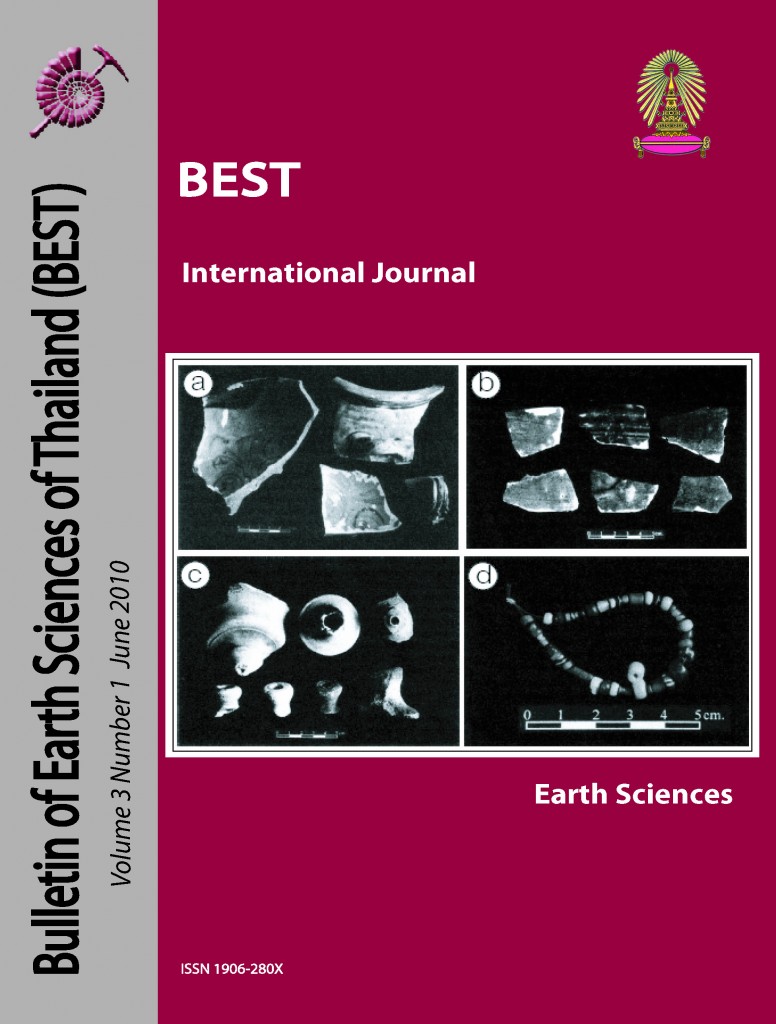One Dimensional Resistivity Sounding for Resolving Gem-bearing Gravel Layer: A Comparison of Schlumberger with Wenner Techniques at Bo Rai, Eastern Thailand
Main Article Content
Abstract
A direct detection of gem-bearing gravel is very difficult in areas covered by basaltic layer, especially in the eastern Thailand gem field, since the resistivity contrast between the gravel and basalt layers is usually much greater than the resistivity contrast within the bedrock itself. Electrical resistivity surveys are considered to be the most effective method for resolving gem-bearing gravel overlain by basalt environment. Schlumberger and Wenner electrode array configurations were applied to resistivity sounding in order to compare their effectiveness in the eastern Thailand gem field. When compared with a known lithological section in the Bo Rai area, Thailand, both survey arrays in this study were able to detect a high resistivity layer of gem bearing gravel layer, which is located under the basalt. However, the Schlumberger array is clearly more suitable for detecting zones of local gem-bearing gravel layers being more efficient, faster and more economical than the Wenner array. Thus the Wenner array is considered an option only in terrains where Schlumberger sounding cannot be conducted due to a lack of open space.
Article Details

This work is licensed under a Creative Commons Attribution-NonCommercial-NoDerivatives 4.0 International License.
Copyright © 2008 Department of Geology, Faculty of Science, Chulalongkorn University. Parts of an article can be photocopied or reproduced without prior written permission from the author(s), but due acknowledgments should be stated or cited accordingly.
References
Barr, S.M. and Macdonald, A.S., 1981. Geochemistry and geochronology of late Cenozoic basalts of Southeast Asia. Geological Society of Malaysia 10, 21-48.
Beresnev, I.A., Hruby, C.E. and Davis, C.A., 2002. The use of multi-electrode resistivity imaging in gravel prospecting. Journal of Applied Geophysics 49, 245-254.
Dahlin, T. and Loke, M.H., 1998. Resolution of 2D Wenner resistivity imaging as assessed by numerical modeling. Journal of Applied Geophysics 38, 237– 249.
Jakosky, J.J., 1950. Exploration Geophysics. 2nd edition, Trija Publishers, Los Angeles.
Jungyusuk, N. and Khositanont, S., 1992. Volcanic rocks and associated mineralization in Thailand, In: Proceeding of a National Conference on
Geologic Resources of Thailand, Potential for Future Development, Bangkok, Thailand, 126-134.
Parasnis, D.S., 1997. Principles of Applied Geophysics. 5th edition. Chapman & Hall, London, New York. Salyaphongse, S. and Jungyusuk, N., 1983.
Geological map of Thailand 1:500,000; Central and Eastern Sheet: Geological Survey Division, Department of Mineral Resources, Bangkok, Thailand.
Sirinawin, T., 1981. Geochemistry and Genetic Significance of Gem-bearing Basalt in Chanthaburi-Trat Area. Master Thesis (Unpublished), Department of Geological sciences, Chiang Mai University, Thailand (in Thai with English abstract).
Telford, W.M., Geldart, L.P. and Sheriff, R.E., 1990. Applied Geophysics. 2nd edition. Cambridge Univ. Press, New York. Vichit, P., 1992. Gemstones in Thailand. In the Proceeding of a National Conference on Geologic Resources of Thailand, Potential for Future Development, Bangkok, Thailand. 126-134.
Welkie, C.J. and Meyer, R.P., 1983. Geophysical evidence that the Haeger Till member underlies southern western Lake Michigan. Geoscience 8, 45-48.
Yui, T.F., Wu, C.M., Limtrakun, P., Srichan, W. and Boonsoong, A., 2006. Oxygen isotope studies on placer sapphire and ruby in the Chanthaburi-Trat alkali basaltic gemfield, Thailand. Lithos 86. 197-211.


